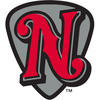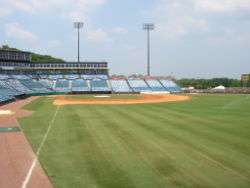Nashville Sounds
|
Nashville Sounds Founded in 1978 Nashville, Tennessee | |||||
| |||||
| Class-level | |||||
|---|---|---|---|---|---|
| Current | Triple-A (1985–present) | ||||
| Previous | Double-A (1978–1984) | ||||
| Minor league affiliations | |||||
| League | Pacific Coast League (1998–present) | ||||
| Conference | American Conference | ||||
| Division | Northern Division | ||||
Previous leagues |
| ||||
| Major league affiliations | |||||
| Current | Texas Rangers (from 2019) | ||||
| Previous |
| ||||
| Minor league titles | |||||
| League titles (3) |
| ||||
| Conference titles (2) |
| ||||
| Division titles (10) |
| ||||
| Second half titles (6) |
| ||||
| Team data | |||||
| Nickname | Nashville Sounds (1978–present) | ||||
| Colors |
Red, black, platinum silver | ||||
| Mascot | Booster | ||||
| Ballpark | First Tennessee Park (2015–present) | ||||
Previous parks | Herschel Greer Stadium (1978–2014) | ||||
Owner(s)/ Operator(s) | MFP Baseball / Nashville Sounds Baseball Club | ||||
| Manager | Jason Wood | ||||
| General Manager | Adam Nuse | ||||
| Media | MiLB.TV and ALT 97.5 FM | ||||
The Nashville Sounds are a Minor League Baseball team of the Pacific Coast League (PCL) and the Triple-A affiliate of the Texas Rangers. They are located in Nashville, Tennessee, and are named for the city's association with the music industry. The team plays its home games at First Tennessee Park which opened in 2015 and is located on the site of the historic Sulphur Dell ballpark. The Sounds previously played at Herschel Greer Stadium from its opening in 1978 until the end of the 2014 season.
Established as an expansion team of the Double-A Southern League in 1978, the Sounds were replaced by a Triple-A American Association team in 1985. The Triple-A Sounds carried on the history of the Double-A team that preceded it. The Sounds later joined the PCL in 1998. The team has served as a farm club for eight major league franchises. A total of 28 managers have led the club and its over 1,200 players. Through the 2018 season, the team has played in 5,866 regular season games and compiled a win–loss record of 3,017–2,849 (.514).[1]
The Sounds have reached the postseason on 14 occasions. They have won ten division titles, two conference titles, and three league championships. Most recently, they won the PCL championship in 2005 as the Triple-A affiliate of the Milwaukee Brewers. Previous league titles won by the team are the Southern League championship in 1979 as the Double-A affiliate of the Cincinnati Reds, and again in 1982 as the Double-A affiliate of the New York Yankees. The team has an overall postseason record of 42–41 (.506).
The team fielded in 1980 was recognized as one of the 100 greatest minor league teams of all time. The 2006 team tied the record for the longest game in PCL history (24 innings). Of the three nine-inning perfect games in the history of the PCL, two have been pitched by members of the Sounds. In 2016, Forbes listed the Sounds as the 19th-most valuable Minor League Baseball team with a value of $30.5 million.[2]
History
Prior professional baseball in Nashville
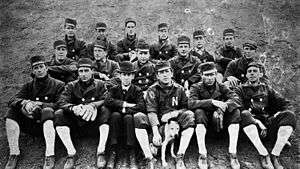
Nashville has hosted Minor League Baseball teams since the late 19th century. The city's professional baseball history dates back to 1884 with the formation of the Nashville Americans who were charter members the original Southern League from 1885 to 1886 and played their home games at Athletic Park, later to be called Sulphur Dell.[3][4] This ballpark was the home of Nashville's minor league teams through 1963. In 1887, Nashville's Southern League team was called the Nashville Blues.[5] The Nashville Tigers competed for the city in the same league from 1893 to 1894.[5] In 1895, the Nashville Seraphs won the city's first professional championship in the Southern League.[5] The Nashville Centennials played in the Central League in 1897, but relocated to Henderson, Indiana, during the season before the league's collapse.[6]
The city's longest-operating baseball team, first known as only the Nashville Baseball Club and later nicknamed the Nashville Vols (short for Volunteers), was formed in 1901 as a charter member of the Southern Association.[7] They remained in the league through 1961, winning eight pennants, nine playoff championships, and four Dixie Series titles.[8][9] The league disbanded after the 1961 season, and no team was fielded in 1962, but the Vols played one final season in the South Atlantic League in 1963.[10] Sulphur Dell was demolished in 1969,[11] and the city went without a professional baseball team for 14 years until 1978.
Getting a team and building a ballpark
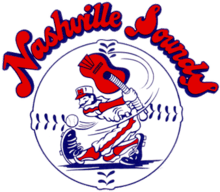
Larry Schmittou, head coach of the Vanderbilt Commodores baseball team from 1968 to 1978, was instrumental in bringing professional baseball back to Nashville. Along with help from country music star Conway Twitty, Schmittou put together a group of investors including other country stars Cal Smith, Larry Gatlin, Jerry Reed, and Richard Sterban, as well as other Nashvillians, in order to finance a stadium and a team.[12][13] The Metro Parks Board agreed to lease to Schmittou the site of Nashville's former softball fields on the grounds of Fort Negley, an American Civil War fortification approximately two miles (3 km) south of downtown, on which to build.[14] The ballpark would be named Herschel Greer Stadium in posthumous honor of Herschel Lynn Greer, a prominent Nashville businessman and the first president of the Nashville Vols baseball team.[15] Schmittou and general manager Farrell Owens landed the Cincinnati Reds as a major league affiliate after meeting with Sheldon "Chief" Bender, Cincinnati's farm director, at the 1976 Winter Meetings.[16] The team was then granted membership in the Southern League, a class Double-A league.[17]
The team was called the Sounds in reference to the "Nashville sound," a subgenre of American country music that traces its roots to the area in the late-1950s.[18] The team's wordmark and color scheme were lifted from the defunct Memphis Sounds of the American Basketball Association (ABA), who used them from 1974 to 1975.[19] The color blue was added to Memphis' red and white palette. Nashville's original logo, which was used from 1978 into 1998, reflected the city's association with country music.[20] It depicted a mustachioed old-time baseball player, nicknamed "Slugger," swinging at a baseball with a guitar, a staple of country music, in place of a bat.[18] Further illustrating the city's musical ties was the typeface, with letters resembling musical notes and treble clefs, used to display the team name.[18]
Southern League
Cincinnati Reds (1978–1979)
With a team in place and a stadium under construction, the Nashville Sounds were set to begin play in 1978 as an expansion team of the Southern League.[21] As the Double-A affiliate of the Cincinnati Reds,[21] the Sounds played their first game on April 15, 1978, against the Memphis Chicks at Memphis' Tim McCarver Stadium, which they lost, 4–2.[22] The Sounds recorded their first win the next evening, defeating Memphis, 3–0.[23] On April 26, the Sounds played their first home game, a 12–4 victory, against the Savannah Braves in front of a sellout crowd of 8,156 fans.[24]
The Sounds incurred more success at the turnstiles than on the field, having failed to win either half of the Southern League's split-season,[25] as they led all of Minor League Baseball in attendance by drawing 380,000 fans.[13] Nashville went on to lead the Southern League in attendance in each of their seven seasons as a member of the league.[13] Larry Schmittou's business philosophy revolved around earning profits not from ticket sales, but from the sale of souvenirs and concessions.[26] This philosophy also involved promoting entertainment value, or fun, as much or more than promoting the baseball game.[27] The franchise was recognized for its promotion efforts when it won the Larry MacPhail Award for outstanding minor league promotions in 1978, 1980, and 1981.[28]
Manager George Scherger led the 1979 Sounds to win the second-half Western Division title, qualifying them for the postseason. After defeating Memphis, three games to one, to win the Western Division championship, they advanced to the league championship series against the Columbus Astros. Nashville captured their first Southern League championship by defeating the Astros, three games to one.[29]
After Cincinnati refused to allow Nashville to continue using a designated hitter in their lineups, Schmittou chose not to renew the team's player development contract with the Reds.[27] After two seasons at Double-A for the Reds, Nashville had a 147–138 record.[30]
New York Yankees (1980–1984)
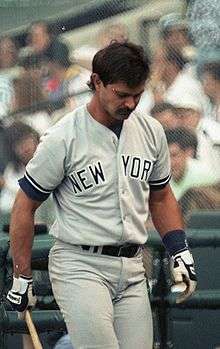
Larry Schmittou had been encouraged by the New York Yankees organization to establish the Sounds as a Triple-A team, but he refused to go back on his previous agreement to partner with the Reds at Double-A.[27] After the split with Cincinnati, the Sounds made their first affiliation switch in 1980, becoming the Double-A affiliate of the Yankees. This partnership was the most successful period in Sounds franchise history. They experienced five winning seasons in a row and won five consecutive second-half Western Division titles, propelling them to the postseason each year.
Under manager Stump Merrill, the 1980 Sounds finished the season with a franchise-best 97–46 record.[31] They won the second half of the season, qualifying them for the Western Division championship series, but lost to the Memphis Chicks, three games to one.[21] In 2001, the 1980 Sounds were ranked as the sixty-ninth greatest minor league baseball team of all-time by baseball historians.[21] The team also set a league attendance record that year, which still stands as of the end of the 2017 season, when a total of 575,676 fans visited Greer Stadium.[21] The Sounds returned to the Western Division finals in 1981, this time falling to the Orlando Twins, 3–1.[32]
The 1982 Sounds, under manager Johnny Oates, finished with a 77–67 record and won the second half of the season, setting them up to play the Knoxville Blue Jays in the division playoffs.[33] After defeating the Blue Jays, 3–1, the Sounds advanced to the league championship series against the Jacksonville Suns. They defeated the Suns, 3–1, winning the Southern League championship and giving the franchise its second league title.[29]
The Sounds returned to the Western Division championship series in each of the next two seasons, but fell to the Birmingham Barons, 3–2, in 1983, and to the Knoxville Blue Jays, 3–1, in 1984.[34][35] Also in the 1984 season, Jim Deshaies pitched the club's first no-hitter against the Columbus Astros in the second game of a seven-inning doubleheader on May 4.[36] Otis Nixon set the career franchise record in stolen bases (133) during the 1981 and 1982 seasons.[37] Pitcher Jamie Werly set the strikeout record (352) when he played for the Sounds in 1980, 1981, and 1983.[37] Nashville accumulated a 417–306 record during their five-year affiliation with the Yankees.[30]
American Association
Detroit Tigers (1985–1986)
Sounds President Larry Schmittou noticed a slight decline in attendance in 1983 and 1984 and a decrease in local media coverage.[38] In order to boost interest in the team, Schmittou tried, unsuccessfully, to purchase a Triple-A franchise late in the 1983 season. His desire to land a Triple-A team was part of a larger plan to put Nashville in a position to contend for a major league franchise in the future.[39]
Schmittou and team owners arrived at terms in June 1984 to purchase the Triple-A Evansville Triplets of the American Association, with plans to move the franchise from Evansville, Indiana, to Nashville for the 1985 season.[38] The Southern League wanted Schmittou to surrender his franchise to the league, but he had plans to relocate the team instead.[40] Nashville's existing Southern League franchise was moved to Huntsville, Alabama, where the team became the Huntsville Stars.[40] The Triple-A Sounds carried on the history of the Double-A team that preceded it. The Triplets' legacy was retired, and the Stars were established as an entirely-new franchise.
The Sounds entered the Triple-A class level in 1985 as an affiliate of the Detroit Tigers playing in the American Association. Their first Triple-A game was a 3–1 win against the Buffalo Bisons played at Greer Stadium on April 11.[41] Nashville ended their initial season with the Tigers at just one game over .500,[42] but experienced a losing season in 1986, their first since the inaugural 1978 campaign.[43] The Sounds ended their affiliation with Detroit after two seasons of poor attendance and a lackluster 1986 season.[39] Their two-year record with the Tigers amounted to 139–144.[30]
Cincinnati Reds (1987–1992)
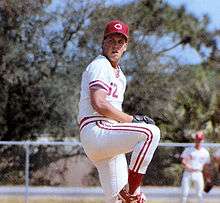
The Sounds rejoined the Cincinnati Reds farm system in 1987, this time as their Triple-A affiliate. The team experienced its most successful season with the Reds at Triple-A and as members of the American Association in 1990 when they compiled an 86–61 record under manager Pete Mackanin.[44] Ending the regular season in a tie with the Buffalo Bisons, the Sounds won the Eastern Division championship in a one-game playoff. They advanced to their first American Association championship series, where they lost to the Omaha Royals, three games to two.[45] That year, Nashville set its all-time attendance record when a total of 605,122 fans came out to Greer Stadium.[46]
Apart from the 1990 season, the Sounds finished too far back to qualify for the postseason in the other five years of affiliation with the Reds. In total, the Sounds put together a 429–433 record with three winning seasons during this time.[30]
Several franchise records were set while serving as the Triple-A Reds. Skeeter Barnes, who had previously played with Nashville in 1979, set the records for games played (514), at bats (1,848), and hits (517) during his second stint from 1988 to 1990.[37] Pitcher Hugh Kemp holds the records for games started (73) and walks (207) from his 1987 to 1989 Sounds career.[37] Joey Vierra, who first pitched for the Sounds from 1990 to 1992, set the franchise record for games pitched during this time and added to his total when he returned to the team in 1994 and 1995 for a total of 238 games.[37]
Greer Stadium, once one of the best stadiums in Triple-A baseball,[47] began to be outshined by newer state-of-the-art ballparks being built in the late 1980s.[48] The Reds let their player development contract with the Sounds expire so they could place their Triple-A affiliate closer and in a city which was planning to build a new stadium.[48]
Chicago White Sox (1993–1997)
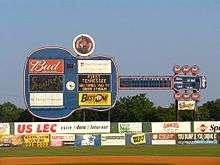
With few options available, the Sounds entered into an affiliation with the Chicago White Sox in 1993.[48] The major league team presented Larry Schmittou with a list of complaints about the relatively poor condition of Greer Stadium. Unable to convince mayor Phil Bredesen or the Metro Council to pay for a new stadium, and deciding against moving the team elsewhere in the Nashville area, Schmittou elected to make significant improvements to Greer.[49] One of those improvements was the addition of its signature guitar-shaped scoreboard, which was installed in 1993.
Greer Stadium was shared between the Sounds and the Southern League's Nashville Xpress, previously known as the Charlotte Knights, during the 1993 and 1994 seasons. This came about when Charlotte acquired a Triple-A expansion franchise in 1993, leaving the city's Double-A team without a home. Schmittou offered Greer as a temporary home ballpark for the team. In order to accommodate an additional club, the Xpress' home games were scheduled during the Sounds' road trips.[50]
The Sounds reached the American Association postseason in each of their first two years with the White Sox. The 1993 team clinched the Eastern Division title with an 81–62 record under manager Rick Renick.[51] In the league championship series, the Sounds lost to the Iowa Cubs, four games to three.[45] The 1994 Sounds qualified for their second consecutive appearance in the league playoffs with a 83–61 record under Renick.[52] In the first round, Nashville swept the New Orleans Zephyrs in three straight games to advance to the league finals, but were defeated by the Indianapolis Indians, 3–1.[45] The team failed to reach the postseason again during the remaining three years of affiliation with Chicago. The five-year relationship with the White Sox ended after the 1997 season with the Sounds having a 383–335 record with four winning seasons over that period.[30]
The 1996 season marked the last that Larry Schmittou was the team's principal owner and president. With the city poised to welcome a National Football League franchise, the Tennessee Titans, Schmittou felt that revenue would be drawn away from his baseball team. So, he sold his entire financial interest in the Sounds to Al Gordon, president of AmeriSports Companies LLC.[27]
Pacific Coast League
Pittsburgh Pirates (1998–2004)
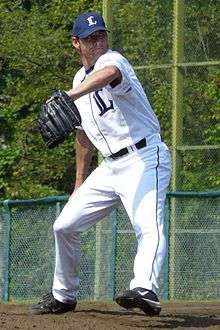
The American Association, of which the Sounds had been members since 1985, disbanded after the 1997 season. Its teams were absorbed by the two remaining Triple-A leagues—the International League and Pacific Coast League. Nashville joined the Pacific Coast League (PCL), making it the eastern-most team in the league.[53] Also, for the first time since the team's foundation in 1978, the Sounds began to adopt a new logo, color scheme, and uniforms over the course of the 1998 and 1999 seasons.[54] The original red, white, and blue colors were replaced by red, black, and white. The new team logo, replacing the original "Slugger", consisted of a black, red, and white music note surrounded by a circle of the same colors bearing the team name in a modern font.
The Sounds entered the Pacific Coast League as the top farm club of the Pittsburgh Pirates. The team regularly finished third or fourth in their four-team division, leaving them out of the playoffs. One of their three winning seasons occurred in 2003 when Trent Jewett managed the Sounds to an 81–62 record, clinching the American Conference Eastern Division title, giving them their first postseason berth in the PCL and first postseason appearance since 1994.[55] Nashville met the Albuquerque Isotopes in the American Conference championship series, defeating the Isotopes, three games to one, but then lost the best-of-five league championship series in three straight games to the Sacramento River Cats.[56]
Also in 2003, right-hander John Wasdin pitched the first perfect game in Nashville Sounds history in his first start of the season against Albuquerque on April 7.[57] The 4–0 Sounds win was only the second nine-inning perfect game in PCL history.[58]
Several franchise records were set during the affiliation with Pittsburgh. Chad Hermansen, who played for the Sounds from 1998 to 2002, holds three career records: runs (303), home runs (92), and runs batted in (286).[37] Tike Redman set the record for the most triples (30) during his time with the team from 2000 to 2003, and added to it later in 2009.[37] Closer Mark Corey set the record for saves (46) during the 2003 and 2004 seasons.[37] The Sounds and Pirates ended their affiliation after seven seasons during which the Sounds had a 490–504 record.[30]
Milwaukee Brewers (2005–2014)
The Sounds changed affiliates in 2005, welcoming the Milwaukee Brewers as their new major league parent club. The Sounds also debuted a new oval-shaped logo with a baseball player silhouetted against a yellow background hitting a ball toward the Nashville skyline with the city's name written in the red border above and the team name written in red and black script below.[18]
The affiliation started well as manager Frank Kremblas led the club to win the American Conference Northern Division title with a 75–69 record.[59] The team went on to win the American Conference title against the Oklahoma RedHawks, three games to two, before sweeping the Tacoma Rainiers in three straight games to win the 2005 Pacific Coast League championship.[56] This was Nashville's first title since their previous league crown in 1982 and their first championship at the Triple-A level.
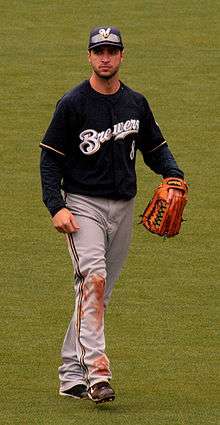
On May 5–6, 2006, the Sounds participated in a 24-inning game against the New Orleans Zephyrs which was played over the course of two days and lasted a total of eight hours and seven minutes. This game matched the longest game, in terms of innings played, in PCL history.[61] The Sounds finished the season with a 76–68 record under Kremblas, tied with the Iowa Cubs for first place,[62] but won the division title and advanced to the postseason by means of having won the regular season series versus Iowa.[63][64] Nashville lost the American Conference championship to the Round Rock Express, 3–2.[56]
On June 25, 2007, Manny Parra pitched the club's second perfect game, only the third nine-inning perfect game in PCL history, against Round Rock.[65] The team, led by Frank Kremblas, captured the division title for the third year in a row and finished the season with a league-best 89–55 record.[66] They were defeated by the New Orleans Zephyrs, 3–1, in the conference championship series.[67]
The Sounds failed to win the division and qualify for the postseason during the next seven years of their Brewers affiliation despite narrow second-place finishes in 2009 and 2014.[68][69] The 2013 team set the record low win–loss record with their 57–87 campaign.[70] Tim Dillard, who pitched for the Sounds from 2007 to 2014, set three franchise records during his Sounds career: wins (39), innings pitched (556⅔), and runs allowed (302).[37]
The team had planned to leave Greer Stadium in the mid 2000s for a new ballpark to be called First Tennessee Field,[71] but the project was abandoned when a financing plan could not be reached.[72][73] After the 2008 season and this failure to secure a new ballpark, Amerisports Companies LLC sold the Sounds to MFP Baseball, a New York-based group of investors consisting of Masahiro Honzawa, Steve Posner, and Frank Ward.[74] MFP made significant renovations to Greer while it continued to explore options for building a new downtown ballpark.[75]
Prior to the 2014 season, the Sounds, Metro Nashville, and the State of Tennessee finalized a plan to build such a ballpark in time for the 2015 season.[76][77] On August 27, 2014, the Sounds hosted the final game at Greer Stadium, an 8–5 loss to the Sacramento River Cats. In his only plate appearance, Nashville catcher Lucas May struck out swinging with a full count and the bases loaded to end the game.[78] The announced attendance at the game was a standing-room-only crowd of 11,067, the first sellout since 2010, and the largest crowd since 2007.[79]
The Sounds severed ties with the Brewers after the 2014 season citing poor on-field performance from recent Brewers Triple-A teams.[80] Over the 10-year affiliation with Milwaukee, the longest in Nashville's history, the Sounds put together a 723–713 record.[30]
Oakland Athletics (2015–2018)
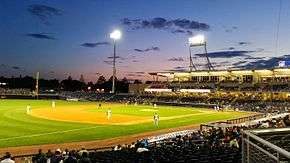
Nashville became the top affiliate of the Oakland Athletics in 2015.[81] The Sounds also adopted a new set of logos and uniforms before the season.[82] Originally, Nashville planned to embrace a new color scheme that included Broadway Burnt Orange, Sunburst Tan, Neon Orange, and Cash Black.[82] However, the team returned to the previous red and black color scheme, with the addition of platinum silver as an accent color, following mixed feedback from fans.[83] The new logos incorporated elements that reflect Nashville's "Music City" moniker, such as guitars, guitar picks, and a guitar's sound hole, as well as neon signs such as those in the city's Broadway entertainment district.[83][18]
The start of the 2015 season marked the first time that the Sounds played at the new downtown First Tennessee Park, which is located at the site of the historic Sulphur Dell ballpark.[84] The Sounds defeated the Colorado Springs Sky Sox, 3–2 in 10 innings, in the inaugural home opener in front of an announced paid attendance of 10,459.[85] First baseman Max Muncy secured the win with a walk-off RBI double, scoring Billy Burns from first base, before being mobbed by his Sounds teammates on the field.[85]
In Nashville's second season as an A's affiliate, they reached the postseason for the first time since 2007 with a league-best 83–59 record and the 2016 American Conference Southern Division title,[86] but were unable to advance past the American Conference series against the Oklahoma City Dodgers, a series they lost three games to two.[87] Joey Wendle, who wore a Sounds uniform from 2015 to 2017, holds the career franchise record for doubles (102).[37] The Sounds finished the 2018 season in second place with a 72–68 record.[88] Nashville declined to renew their contract with the Athletics, which was due to expire at the end of the season, choosing instead to seek a new major league affiliate.[89] Through four seasons of competition as the top farm club of the A's, the Sounds had a 289–276 record, their best record among all affiliations.[30]
Texas Rangers (from 2019)
Nashville entered into a four-year player development contract with the Texas Rangers that runs from 2019 to 2022.[90] The Rangers plan to visit First Tennessee Park for an exhibition game against the Sounds in either the 2019 or 2020 season.[91] The Sounds will participate in Copa de la Diversión ("Fun Cup"), an initiative by Minor League Baseball to connect teams with their local Hispanic communities, in which they will adopt a culturally-relevant on-field persona for certain games during the season. Their promotional moniker will be revealed in March 2019.[92]
Season-by-season results
| Nashville Sounds 5-Year History | |||||||||
|---|---|---|---|---|---|---|---|---|---|
| Year | Regular season | Postseason | MLB affiliate | ||||||
| Record | Win % | League | Division | GB | Record | Win % | Result | ||
| 2014 | 77–67 | .535 | 5th | 2nd | 2½ | — | — | — | Milwaukee Brewers |
| 2015 | 66–78 | .458 | 12th | 3rd | 12 | — | — | — | Oakland Athletics |
| 2016 | 83–59 | .585 | 1st | 1st | — | 2–3 | .400 | Clinched American Conference Southern Division title Lost American Conference title vs Oklahoma City Dodgers, 3–2 | |
| 2017 | 68–71 | .489 | 8th (tie) | 2nd | 22 | — | — | — | |
| 2018 | 72–68 | .514 | 6th (tie) | 2nd | 11 | — | — | — | |
| Totals | 366–343 | .516 | — | — | — | 2–3 | .400 | 1 Division title | — |
Rivals
Nashville's chief rivals have been those based in Memphis, Tennessee. Located approximately 200 miles (320 km) to the southwest and connected to Nashville by Interstate 40, Memphis has fielded several teams which have competed in the same leagues as Nashville's teams since the late 19th century.[93] The Sounds entered the rivalry when they joined the Southern League in 1978 as members of the Western Division in which the Memphis Chicks played.[25] In 1979, the Chicks won the first-half division title and the Sounds won the second-half. In the best-of-three division finals, the Sounds defeated the Chicks, 2–1, before going on to win the Southern League championship.[94] Memphis and Nashville each won the first and second halves, respectively, of the 1980 season. This time, however, Memphis won the Western Division title, defeating Nashville, 3–1.[94] The teams met again under the same circumstances in 1981 when the Sounds swept the Chicks in three straight games to win the Western Division finals.[94]
The intrastate rivalry was interrupted when Nashville moved to the American Association in 1985, but was renewed when the Sounds joined the Pacific Coast League in 1998.[95] The Sounds and the Memphis Redbirds have been division rivals ever since.[96] In 2009, Memphis clinched the American Conference Northern Division title, finishing the season just two games ahead of Nashville which had spent the majority of the season in first place.[68] Similarly, Nashville finished the 2014 season two-and-a-half games behind Memphis after having led the American Conference Southern Division for most of the season.[69] In 2015, the Sounds clinched the division title in Memphis.[97] Roles were reversed in 2016 as the Redbirds clinched the division in Nashville.[98] The Redbirds defeated the Sounds in Memphis to win the 2018 division title.[99]
As of the completion of the 2018 series, Memphis leads the all-time series against Nashville with a record of 920–895 (.507).[100] This record encompasses all 94 years of competition in the original Southern League, Southern Association, Southern League, and Pacific Coast League. Nashville, however, leads the 21-year PCL series with a record of 177–156 (.532).[101]
Ballparks
Herschel Greer Stadium (1978–2014)
The Sounds originally played at Herschel Greer Stadium from 1978 through 2014. The ballpark, which has been abandoned but still stands, is located on the grounds of Fort Negley, an American Civil War fortification approximately two miles (3 km) south of downtown Nashville. The venue experienced numerous expansions and contractions after its completion in 1978,[102] but seated 10,300 spectators during its final 2014 season.[103] The largest attendance occurred on August 18, 1982, when 22,315 people saw the Sounds take on the Columbus Astros.[104] Greer's best known feature, installed in 1993, is the giant 115.6 foot (35.2 m) guitar-shaped scoreboard behind the left field wall.
Following the construction of newer, relatively luxurious minor league ballparks in the 1990s, Greer Stadium had fallen below the standards set for Triple-A stadiums by professional baseball.[47] At the time, team president Larry Schmittou tried to convince the city to approve a new ballpark, but was unsuccessful.[47] Throughout the 2000s, the team continued in its attempts to gather approval and financing for a new ballpark to replace Greer.[105] At one point, First Tennessee Field was planned for construction on the west bank of the Cumberland River in downtown. Disagreements over who would pay for the ballpark repeatedly pushed back opening day at the stadium, and eventually resulted in the cancellation of the project altogether.[106] In the meantime, numerous upgrades and repairs, including over $2.5 million worth of improvements from 2008 to 2009, were made to Greer in order to preserve its functionality until a new stadium could be built.[107] A deal for such a new ballpark was achieved in late 2013. The Sounds played their final game at Greer on August 27, 2014.[79]
First Tennessee Park (2015–present)
The Sounds' current home ballpark is First Tennessee Park, which opened on April 17, 2015.[84] It is located in downtown Nashville at the location of the former Sulphur Dell ballpark.[108] The $91 million stadium has a fixed seating capacity of 8,500 people, but can accommodate up to 10,000 people with additional grass berm seating.[109][110] The ballpark's attendance record was set on July 3, 2017, when 11,764 people watched the Sounds play against the Oklahoma City Dodgers on the night of the team's Independence Day celebration.[111] The stadium features wide concourses with direct views of the playing field. Its design, which incorporates the use of musical and baseball imagery, is meant to connect the park with the city's baseball and musical heritage.[112] This is accomplished through the use of directional signage displaying information on Nashville's former teams and players, the grandstand's light stanchions reminiscent of those found at Sulphur Dell, and the use of the team's guitar pick logo throughout the park.[109]
One of First Tennessee Park's most recognizable features, like Greer Stadium before it, is a 142 by 55 foot (43 by 17 m) guitar-shaped scoreboard beyond the right-center field wall.[112][113] Unlike Greer's guitar, which was only able to display basic in-game information such as the line score, count, and brief player statistics, the new, larger version is also capable of displaying colorful graphics, animations, and videos, the batting order, fielding positions, expanded statistics, and player photographs.[114] Other distinguishing features at the ballpark include The Band Box, an outdoor restaurant and bar which serves variations on traditional ballpark foods,[109] and The Country Club at The Band Box, a 9-hole miniature golf course which exhibits art from different local and regional artists.[115]
In 2016, the Sounds added the Country Legends Race, similar to major league mascot races, such as the Sausage Race and Presidents Race, to the between-innings entertainment at the park. In the middle of the fifth inning, people in oversized foam caricature costumes depicting country musicians Johnny Cash, George Jones, Reba McEntire, and Dolly Parton race around the warning track from center field, through the visiting bullpen, and to the home plate side of the first base dugout.[116][117]
Uniforms
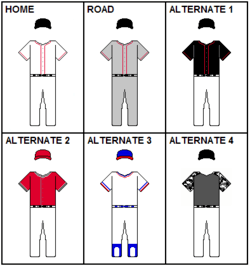
Nashville's current uniforms, adopted in 2015, utilize the team's red, black, and platinum silver color palette and incorporate elements that reflect Nashville's "Music City" moniker.[83] Home uniforms consist of white jerseys with single lines of red piping around the sleeve openings and up the front going around the neck. The word "Sounds" is printed on the chest in red letters which resemble the sound holes on a guitar with a silver and black border. A swinging guitar logo is located on the left sleeve, while a green Oakland Athletics elephant logo is found on the right. A two-tone green state of Tennessee logo bearing the letters "FYKE" is displayed on the left shoulder in memoriam of Jim Fyke, a Metro government employee and state official who played an integral role in securing a new ballpark.[118] The player's last name is sewn on the back in black block characters, and his number is displayed below in red sound-hole lettering with a silver border and black drop shadow. White pants with a single line of red piping going up the sides are worn with black belts and black socks. The home cap is solid black with the primary "N" guitar pick logo. Batting helmets are glossy black with the same "N" pick logo.[119] Road uniforms are identical to those worn for home games with only a few exceptions: jerseys and pants are gray, "Nashville" is written across the chest, the pants have no pinstripes, and the cap bears an "S" guitar pick logo.[119]
The team wears a black alternate jersey for all Monday home games and frequently on the road in place of the traditional gray road jersey.[120] These mesh jerseys are similar to the home and road versions, but with "Music City" written across the chest, no names on the back, and "Nashville" sewn in red letters under the Athletics sleeve logo. They are usually paired with a cap with the letters "MC", for "Music City", over a guitar pick.[18][119] Alternate red jerseys are worn for all Friday home games and frequently on the road. These are made from red material with black and white bands at the neck opening and bands of silver, black, and white around the sleeve openings. A guitar's fret and headstock extend upward from these bands on each sleeve. "Nashville" is printed across the chest in white sound-hole lettering bordered by silver and black. The player's number is located below the city's name on the player's left chest and on the back in silver characters with a white border and black drop shadow. This jersey is paired with solid red cap bearing a spinning black vinyl record with white stars from the flag of Tennessee on the center red label set against a white and black silhouette of the state of Tennessee.[121]
A third set of alternate uniforms honoring the 1978 Sounds are worn for Thursday home games in conjunction with Throwback Thursday promotions.[120] The jerseys, similar to those worn by the 1978 team, are white pullover v-necks with bands of red, white, and blue around the neck, with larger bands at the sleeve openings. "Sounds" is written across the chest in red-on-blue music note-like script, with the player's number below on the player's left chest in blue block characters with a red border. The right sleeve bears the round "Slugger" patch. High white pants are worn with blue belts and blue stirrups. The cap is blue with a red brim, displaying an "N" styled like a music note in white bordered by red.[122] The team wears gray jerseys with black, white, and gray digital camouflage sleeves paired with white pants and home caps for all Sunday home games as a part of Military Sundays.[120] These pullover jerseys have the same "Sounds" wordmark and back numbers as appear on home uniforms. The player's number is located on the front and an American flag appears on the left sleeve.[123]
Past
The team has utilized two color palettes prior to its current color scheme. The original colors, used from 1978 to 1998, consisted of red, white, and blue. From 1998 to 2014, the Sounds used a red and black palette similar to the club's current colors. Both color schemes were used in the 1998 season during the transition from one to the other.
From 1978 to 1986, the team wore pullover v-neck jerseys made of white fabric, for home games, gray, for road games, and red or blue, for use as alternates. These had bands of red, white, and blue around the neck, with larger bands at the sleeve openings (the blue jerseys had one white band and two red bands). "Sounds" was written across the chest in red-on-blue music note-like script. Numbers were sewn on the back.[124] The team's pants were white and also had small red, white, and blue stripes down the legs and larger stripes around the waistband. Similar gray pants were worn for road games. Beginning in 1984, numbers were also located on the front of jerseys on the player's left chest, below the team name.[125] The team cap was blue with a red brim bearing an "N" styled like a music note in white bordered by red; this was the official team cap from 1978 through the mid-1990s.[125]
From 1987 to 1998, the team wore button up jerseys made of white fabric, for home games, and gray, for road games. The design of the home jerseys remained mostly the same as their previous uniforms. "Sounds" was still written across the chest in blue music note script with a red border; though, the font was changed briefly from 1987 to 1988. Numbers were present on the front below the team name on the player's left chest in blue block characters with a red border.[126] The back displayed the player's number; names were also present during some years. Road grays had "Nashville" written across the chest and were missing the tri-color bands at both the neck and sleeves.[126] During this time, the team also added a blue mesh v-neck jersey with the red and white guitar swinger logo on the left chest. The wide tri-color stripes were dropped from the pants and were replaced by a blue belt. The Sounds continued to wear the original red-billed blue cap with all uniforms until approximately 1993 when a new cap was introduced. This new all-blue cap added the "Slugger" to accompany the "N."[127] The two caps were worn interchangeably through 1998.
The team switched to a red and black color scheme over the course of the 1998 and 1999 seasons.[54] In the latter, uniforms consisted of black-pinstriped pants and jerseys, with black sleeves bearing a music note logo on the left.[126] White home jerseys had "Sounds" written across the chest in red with a white-on-black border using the same font used by the Anaheim Angels at the time. Road grays read "Nashville" on the chest in the same style. Both had the player's number sewn on the back in block characters in the same colors. There was also an alternate jersey made of solid red fabric with black and gray trim around the sleeve openings and a music note logo on the left chest. Another alternate, made of black material, had red and white trim at the sleeve openings and a similar music note logo on the left chest.
In 2003, the team switched to solid white pants and jerseys for home games. "Sounds" was written across the chest in red script surrounded by black, there was red and black piping around sleeve openings, around the neck, and along the row of buttons going up the chest, a music note logo on the left sleeve, and numbers on the front of jerseys below the team name.[128] Pants had the same piping going down the legs on the outside. From 2006 to 2012, similar jerseys without sleeves or the player's number on the front were worn. These vest-like jerseys were worn over black T-shirts of varying sleeve lengths.[129] Player's names were written on the back in black block characters; numbers were also displayed in large red characters with black borders. Road jerseys initially bared "Sounds" across the chest, but were later changed to "Nashville"; these usually lacked the player's name on the back. A Milwaukee Brewers logo was added to the front left shoulder in 2007. The official home and road caps were black with a red and white music note logo on the front.[129]
From 2013 to 2014, team jerseys were made of mesh material with black sections at the armpits and a single line of black piping going down the sleeves and across the shoulders to the neck. A Brewers logo was sewn on the left sleeve. On home jerseys, "Sounds" was written across the chest in red script surrounded by black. The player's name was displayed on the back in black block characters; numbers were also shown in large red characters with black borders. Road jerseys were the same, but with "Nashville" across the chest, red underarm sections and piping, and no name on the back. The team's alternate uniforms from 2010 to 2014 were similar to these jerseys, but were red with black underarm sections and piping. "Sounds" was written across the chest in white, black-bordered script. A Brewers logo was located on the left, front shoulder. Numbers, in white surrounded by black, were sewn on the back in block characters.[130]
 1978–1986 |
 1987–1998 |
 1999–2002 |
 2003–2005 |
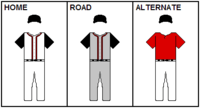 2006–2007 |
 2008–2012 |
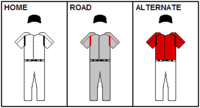 2013–2014 |
 2015–2016 |
 2017–present |
Radio and television
During the opening season of 1978, Nashville Sounds games were broadcast on WMTS 96.3 FM by announcer and station owner, Monte Hale. He died following the inaugural season, after which Bob Jamison was hired for the 1979 season. Jamison remained the voice of the Sounds through 1990 when he was hired as the radio broadcaster for the California Angels. Nashville-native and future sports talk show host George Plaster served as a color commentator from 1980 to 1981 and 1985 to 1986. The Sounds hired Steve Carroll as lead broadcaster in 1991. Carroll left after 1995 to become the radio voice of the NHL's Philadelphia Flyers.
Steve Selby served as the lead broadcaster for the Sounds from 1996 to 1999, when he left to call games for the Memphis Redbirds.[131] Chuck Valenches, a former assistant broadcaster, was promoted to the play-by-play role from 2000 to 2009. Stu Paul was the voice of the Sounds for the 2010 and 2011 seasons.[132] Jeff Hem has been the team's lead broadcaster since 2012.[133] All Sounds home and road games are broadcast on ALT 97.5 FM. Live audio broadcasts are also available online through the team's website and the MiLB First Pitch, iHeartRadio, and TuneIn radio apps.[133]
Games can be viewed through the MiLB.TV subscription feature of the official website of Minor League Baseball, with audio provided by a radio simulcast.[134] Sounds home games were regularly televised by WZTV from 1982 to 1992. A few games were also aired by WNPX in 1999.[135] From 2005 to 2008,[136] a monthly television program, called Sounds On Demand, aired throughout Middle Tennessee via Comcast cable.[136] The 30-minute show, hosted by Chuck Valenches, featured player interviews, team news, tips from players on how to play the game, and other related content.[136]
Mascots
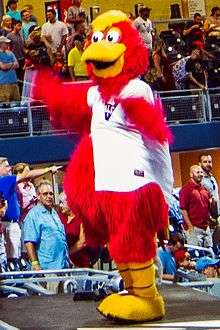
The Nashville Sounds' mascot is an anthropomorphic rooster named Booster. He is bright red with yellow legs, beak, comb, and palms and red, orange, and yellow tail feathers resembling flames. He wears the same style jerseys as the team with the number zero on the back. He made his debut on April 17, 2015, at the Sounds' first game at First Tennessee Park. His name refers to "boosting" or building enthusiasm for the team, while his appearance is a play on Nashville hot chicken.[137]
The first Sounds mascot was introduced during the team's inaugural 1978 season. Homer Horsehide resembled their major league affiliate's mascot — Mr. Red of the Cincinnati Reds. The character was human in appearance, with the exception of an oversized anthropomorphized baseball in place of a human head. The mustachioed mascot donned a uniform identical to that of Sounds players.[138][139]
From 1995 to 1996, a lime-green dinosaur named Champ, borrowed from the Vermont Expos, was the team's mascot.[140] Following altercations with team management and league personnel during games, Champ, vis-à-vis his performer, did not return for the 1997 season.[141]
An anthropomorphic cougar named Ozzie was the team's mascot from 1997 to 2014. The original Ozzie came from the Class A Kane County Cougars minor league team, which had an extra mascot costume. The surplus cougar outfit was sent to Nashville, and, after building a fan following during Ozzie's first season, team management decided to make him the permanent mascot.[142] The original Ozzie costume was brown, but a new yellow costume was introduced in 1998. Ozzie wore the same style of uniform as the team, but with no hat. Ozzie was retired when the Sounds left Greer Stadium in 2014, although he continued to make appearances during the 2014 to 2015 offseason.[137]
Roster
Nashville Sounds roster | ||||
|---|---|---|---|---|
| Players | Coaches/Other | |||
|
Pitchers
|
Catchers
Infielders
Outfielders
|
Manager
Coaches
| ||
Achievements
Awards
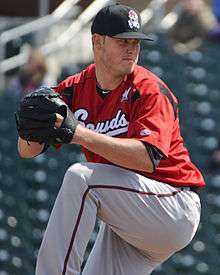
Fourteen players have won league awards in recognition for their performance while with the Sounds. Three players have won league Most Valuable Player (MVP) awards. Steve Balboni (1980) and Brian Dayett (1982) won the Southern League MVP Award,[143] and Magglio Ordóñez (1997) won the American Association MVP Award.[144] Ten players have won Pitcher of the Year honors. Bruce Berenyi (1978), Geoff Combe (1979), Andy McGaffigan (1980), Jamie Werly (1981), and Stefan Wever (1982) were selected for the Southern League Most Outstanding Pitcher Award.[145] Chris Hammond (1990) and Scott Ruffcorn (1994) won the American Association Most Valuable Pitcher Award.[144] R.A. Dickey (2007), Johnny Hellweg (2013), and Jimmy Nelson (2014) were selected for the PCL Pitcher of the Year Award.[146] Jeff Abbott (1996) and Magglio Ordóñez (1997) won the American Association Rookie of the Year Award.[144] Ordóñez is the only Sounds player to win multiple league awards.
Four managers have been selected as their league's Manager of the Year. Stump Merrill (1980) won the Southern League Manager of the Year Award,[147] Rick Renick (1993 and 1996) won the American Association Manager of the Year Award,[144] and Frank Kremblas (2007) and Steve Scarsone (2016) have won the PCL Manager of the Year Award.[146]
Seventy-two players have been selected for midseason All-Star teams.[148] Of those players, Joey Vierra (1992 and 1995), Drew Denson (1993–94), and Vinny Rottino (2007–08) are the only players to have been selected twice while playing for Nashville.[148] Four players have been chosen as the MVP for midseason All-Star games: Duane Walker (1979),[149] Ray Durham (1994), Magglio Ordóñez (1997), and Renato Núñez (2017).[148] Of the 50 players who have been named to postseason All-Star teams, only Duane Walker (1979 in two positions) and Jeff Abbott (1996 and 1997) have been selected twice.[150][151]
Retired numbers
Nashville has honored two of its players by retiring their uniform numbers.[152] This ensures that the number will be associated with one player of particular importance to the team. Nashville displays its retired numbers on the front of the press box at First Tennessee Park.
| Skeeter Barnes | Don Mattingly | Jackie Robinson |
| OF / 3B / 1B 1979, 1988–1990 Retired early 1990s | 1B / OF 1981 Retired August 12, 1999 | Retired throughout professional baseball on April 15, 1997 |
Hall of Famers
Four former members of the Sounds have been elected to the National Baseball Hall of Fame. Closing pitcher Trevor Hoffman, who was inducted in 2018,[153] played the majority of the 1992 season with Nashville while working his way up through the Cincinnati Reds' organization. Hoffman appeared in 42 games, working out of the bullpen on 37 occasions, and achieved a 4–6 record with a 4.27 earned run average (ERA) and 63 strikeouts over 65 1⁄3 innings of work.[154] He later made two major league rehabilitation appearances while with the Milwaukee Brewers in 2009.[154] Two other Hall of Fame players appeared in games for Nashville solely on rehab assignments. Shortstop Barry Larkin, who was inducted in 2012,[155] appeared in two games in 1989.[156] Outfielder Tim Raines, who played three games with Nashville in 1993,[157] was inducted in 2017.[158] Hoyt Wilhelm, the Sounds' pitching coach from 1982 to 1984,[159] was inducted in 1985.[160] Under his three years' guidance, the team's pitching staff amassed a 239–198 record with a 3.73 ERA and 2,357 strikeouts.[33][35][161]
The Sounds are also represented in the Southern League Hall of Fame. Larry Schmittou, who helped bring baseball to Nashville in 1978 and was the principal owner through 1996, was inducted in 2016.[162]
Managers
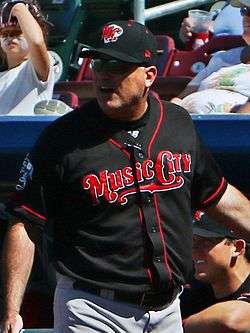
Over the course of 41 seasons, the Nashville Sounds have employed 28 managers.[163] Three managers have guided the team to win their league's championship.[164] George Scherger (1979) and Johnny Oates (1982) led the team to win the Southern League championship.[165] Frank Kremblas (2005) led them to win the Pacific Coast League championship.[166] Trent Jewett is the longest-tenured manager in team history, having managed the team for 625 games from 1998 to 2000 and 2003 to 2004.[163] The manager with the highest winning percentage over a full season or more is Stump Merrill, who led the Sounds to a .622 winning percentage from 1980 to 1981.[163]
| Nashville Sounds Managerial Record (Last Five Managers) | ||||||||||
|---|---|---|---|---|---|---|---|---|---|---|
| # | Manager | Years | Regular season | Postseason | ||||||
| Games | Wins | Losses | Win % | Appearances | Wins | Losses | Win % | |||
| 23 | Mike Guerrero[a] | 2012–2013 | 288 | 124 | 164 | .431 | — | — | — | — |
| 25 | Rick Sweet | 2014 | 144 | 77 | 67 | .535 | — | — | — | — |
| 26 | Steve Scarsone | 2015–2016 | 286 | 149 | 137 | .521 | 1 | 2 | 3 | .400 |
| 27 | Ryan Christenson | 2017 | 139 | 68 | 71 | .489 | — | — | — | — |
| 28 | Fran Riordan | 2018 | 140 | 72 | 68 | .514 | — | — | — | — |
| Totals | — | 7 years | 997 | 490 | 507 | .491 | 1 | 2 | 3 | .400 |
| a Charlie Greene served as an interim manager for nine games in May 2013. The team had a 2–7 (.222) record during this period.[167] | ||||||||||
See also
References
Specific
- ↑ "Year-By-Year Results". Nashville Sounds. Minor League Baseball. Retrieved May 26, 2017.
- ↑ Klebnikov, Sergei (July 8, 2016). "Minor League Baseball's Most Valuable Teams – 19. Nashville Sounds". Forbes. Retrieved July 14, 2016.
- ↑ Nipper, Skip (October 5, 2016). "First Nashville Professional Games in 1884". 262 Down Right. Retrieved October 10, 2016.
- ↑ Traughber, Bill (April 25, 2011). "Looking Back: The 1885 Nashville Americans". Nashville Sounds. Minor League Baseball. Retrieved January 30, 2015.
- 1 2 3 Traughber, Bill (April 26, 2010). "Looking Back: The 1887 Nashville Blues". Nashville Sounds. Minor League Baseball. Retrieved January 28, 2015.
- ↑ Nipper, Skip (January 18, 2015). "Nashville in the 1897 Central League". 262 Down Right. Retrieved January 28, 2015.
- ↑ Traughber, Bill (May 23, 2011). "Looking Back: The 1901 Nashville Vols". Minor League Baseball. Retrieved February 2, 2015.
- ↑ O'Neal 1994, p. 306–308.
- ↑ Nipper 2007, p. 25.
- ↑ Nipper, Skip (September 8, 2015). "Bye Bye SALLY, Hello Emptiness". 262 Down Right. Retrieved September 23, 2015.
- ↑ Traughber, Bill (August 26, 2013). "Looking Back: Sulphur Dell Demolished in 1969". Minor League Baseball. Retrieved February 6, 2015.
- ↑ Woody 1996, p. 64–65.
- 1 2 3 Nipper 2007, p. 101.
- ↑ Woody 1996, p. 66.
- ↑ Nipper 2007, p. 103.
- ↑ Woody 1996, p. 71–72.
- ↑ Woody 1996, p. 195.
- 1 2 3 4 5 6 Caputo, Paul (June 20, 2015). "That Nashville Sound: The Story Behind the Nickname". SportsLogos.net. Retrieved March 21, 2016.
- ↑ Ruble, Drew (July 2006). "Vestige of Empire". Nashville Post. Archived from the original on February 4, 2012. Retrieved August 1, 2008.
- ↑ Woody 1996, p. 90.
- 1 2 3 4 5 Weiss, Bill; Wright, Marshall (2001). "69. 1980 Nashville Sounds". Minor League Baseball. Retrieved May 9, 2017.
- ↑ "Opening Day Lineups" (PDF). 2015 Nashville Sounds Media Guide. Minor League Baseball. 2015. p. 165. Archived from the original (PDF) on April 7, 2015. Retrieved April 9, 2015.
- ↑ Traughber 2017, p. 127.
- ↑ Traughber, Bill (August 7, 2006). "Looking Back: Sounds' First Game". Minor League Baseball. Archived from the original on October 21, 2008. Retrieved March 8, 2008.
- 1 2 "1978 Southern League". Baseball-Reference.com. Sports Reference LLC. Retrieved May 24, 2017.
- ↑ Pratt, Kristin (July 20, 2006). "25 for 25: Stars in the Baseball America Universe". Baseball America. Archived from the original on April 15, 2016. Retrieved May 24, 2017.
- 1 2 3 4 Traughber, Bill (April 8, 2008). "Commodore History Corner: Q&A with Larry Schmittou". College Sports Television. Retrieved March 25, 2009.
- ↑ "Major Award Winners: Larry MacPhail Award". Minor League Baseball. Retrieved August 22, 2014.
- 1 2 "Southern League Past Champions". Southern League. Minor League Baseball. Retrieved March 1, 2015.
- 1 2 3 4 5 6 7 8 "Year By Year Results". Nashville Sounds. Minor League Baseball. Retrieved May 14, 2018.
- ↑ "1980 Southern League". Baseball-Reference.com. Sports Reference LLC. Retrieved May 24, 2017.
- ↑ "1981 Southern League". Baseball-Reference.com. Sports Reference LLC. Retrieved May 24, 2017.
- 1 2 "1982 Nashville Sounds Statistics". Baseball-Reference.com. Sports Reference LLC. Retrieved May 24, 2017.
- ↑ 1983 Review. The Nashville Sounds 1984 Official Souvenir Program. Nashville Sounds. 1984. pp. 10–11.
- 1 2 "1984 Southern League". Baseball-Reference.com. Sports Reference LLC. Retrieved May 24, 2017.
- ↑ "Eleven No-Hitters Thrown in Sounds History" (PDF). 2015 Nashville Sounds Media Guide. Minor League Baseball. 2015. p. 67. Archived from the original (PDF) on April 7, 2015. Retrieved April 7, 2015.
- 1 2 3 4 5 6 7 8 9 10 "Top Ten Career Leaders". Nashville Sounds. Minor League Baseball. Retrieved July 9, 2017.
- 1 2 Schmittou, Larry (1985). Message from the President. The Nashville Sounds 1985 Official Souvenir Program. Nashville Sounds. p. 8.
- 1 2 Woody 1996, p. 119.
- 1 2 Woody 1996, p. 101–102.
- ↑ "Nashville Then: Nashville Sounds 1985 Season". The Tennessean. October 10, 2015. Retrieved October 26, 2015.
- ↑ "1985 American Association". Baseball-Reference.com. Sports Reference LLC. Retrieved May 24, 2017.
- ↑ "1986 American Association". Baseball-Reference.com. Sports Reference LLC. Retrieved May 24, 2017.
- ↑ "1990 American Association". Baseball-Reference.com. Sports Reference LLC. Retrieved May 24, 2017.
- 1 2 3 "American Association Playoff Results". Triple-A Baseball. Retrieved May 25, 2017.
- ↑ "Yearly Attendance Totals" (PDF). 2015 Nashville Sounds Media Guide. Minor League Baseball. 2015. p. 149. Archived from the original (PDF) on April 7, 2015. Retrieved April 7, 2015.
- 1 2 3 Woody 1996, p. 127.
- 1 2 3 Woody 1996, p. 131.
- ↑ Woody 1996, p. 132–34.
- ↑ O'Neal 1994, p. 287.
- ↑ "1993 American Association". Baseball-Reference.com. Sports Reference LLC. Retrieved May 24, 2017.
- ↑ "1994 American Association". Baseball-Reference.com. Sports Reference LLC. Retrieved May 24, 2017.
- ↑ "Notable Events in American Association History". Triple-A Baseball. Retrieved May 26, 2017.
- 1 2 Russell, Keith (January 22, 1999). "Uniforms, GM part of Sounds' new look". Nashville Business Journal. Retrieved May 25, 2017.
- ↑ "2003 Pacific Coast League". Baseball-Reference.com. Sports Reference LLC. Retrieved May 24, 2017.
- 1 2 3 "Past Champions". Pacific Coast League. Minor League Baseball. Retrieved May 25, 2017.
- ↑ "Wasdin Tosses Perfect Game". Baseball America. April 7, 2003. Archived from the original on April 9, 2015. Retrieved April 9, 2015.
- ↑ "Pacific Coast League No-hit Games". Pacific Coast League. Minor League Baseball. Retrieved August 12, 2015.
- ↑ "2005 Pacific Coast League". Baseball-Reference.com. Sports Reference LLC. Retrieved May 24, 2017.
- ↑ "Rookie of the Year winners". Major League Baseball. Retrieved May 25, 2017.
- ↑ "Sounds, Zephyrs tie PCL record for longest game". ESPN. May 6, 2008. Archived from the original on June 14, 2006. Retrieved July 31, 2008.
- ↑ "2006 Pacific Coast League". Baseball-Reference.com. Sports Reference LLC. Retrieved May 24, 2017.
- ↑ "Pacific Coast League Playoff Procedures". Pacific Coast League. Retrieved September 1, 2014.
- ↑ "2006 Schedule and Results". Nashville Sounds. Minor League Baseball. Retrieved April 7, 2015.
- ↑ McConnell, Ryan (June 25, 2007). "Sounds' Parra Perfect in His Second PCL Start". Minor League Baseball. Retrieved April 8, 2015.
- ↑ "2007 Pacific Coast League". Baseball-Reference.com. Sports Reference LLC. Retrieved May 24, 2017.
- ↑ Blinn, Michael (September 9, 2007). "Mulvey pitches Zephyrs into Finals". Minor League Baseball. Retrieved May 25, 2017.
- 1 2 "2009 Pacific Coast League". Baseball-Reference.com. Sports Reference LLC. Retrieved May 24, 2017.
- 1 2 "2014 Pacific Coast League". Baseball-Reference.com. Sports Reference LLC. Retrieved May 24, 2017.
- ↑ "2013 Pacific Coast League". Baseball-Reference.com. Sports Reference LLC. Retrieved May 24, 2017.
- ↑ "First Tennessee to Put Name on Proposed Sounds Stadium". Nashville Business Journal. November 21, 2003. Archived from the original on April 21, 2015.
- ↑ "Purcell Firm On City, Sounds Stadium Agreement". WSMV. Nashville. September 11, 2006. Archived from the original on October 21, 2008.
- ↑ "Deadline For Sounds Stadium Proposal Passes". WSMV. Nashville. April 16, 2007. Archived from the original on May 24, 2011.
- ↑ Wild, Danny (February 26, 2009). "Sounds makeover begins with new owners, GM". Minor League Baseball. Retrieved May 25, 2017.
- ↑ Rau, Nate (August 29, 2010). "Nashville Sounds search for a new home". The Tennessean. Nashville. Retrieved August 30, 2010.
- ↑ Hale, Steven (December 4, 2013). "Sounds Ballpark Deal Rounds Second, Headed for Final Vote Next Week". Nashville Scene. Retrieved December 8, 2013.
- ↑ "Baseball Has Come Home". Inside Pitch. 4 (1). Nashville. April 17, 2015. pp. 8–19.
- ↑ "Scoreboard: Sacramento at Nashville; August 27, 2014". Nashville Sounds. Minor League Baseball. August 27, 2014. Retrieved May 25, 2017.
- 1 2 Organ, Mike (August 28, 2014). "Greer goodbye gets emotional". The Tennessean. Retrieved August 28, 2014.
- ↑ McCalvy, Adam (September 17, 2014). "Melvin irked over breakup with Triple-A affiliate". Major League Baseball. Archived from the original on August 13, 2017. Retrieved May 25, 2017.
- ↑ Mike, Organ (September 18, 2014). "Nashville Sounds to be Oakland A's affiliate". The Tennessean. Retrieved April 4, 2018.
- 1 2 "What The Sounds Are Really Telling Us With Their Re-Branding". Nashville Scene. October 9, 2014. Retrieved May 25, 2017.
- 1 2 3 "Sounds Unveil New Logos, Uniforms". Minor League Baseball. January 21, 2015. Retrieved May 25, 2017.
- 1 2 Arnold, Sky (April 17, 2015). "Nashville Sounds Opening Day at First Tennessee Park". WZTV. Nashville. Archived from the original on April 18, 2015. Retrieved April 18, 2015.
- 1 2 "Sounds Walk-Off in Home Opener". Minor League Baseball. April 18, 2015. Retrieved May 25, 2017.
- ↑ "2016 Pacific Coast League". Baseball-Reference.com. Sports Reference LLC. Retrieved May 24, 2017.
- ↑ "Sounds Drop Heart-Breaker to End Season". Minor League Baseball. September 11, 2016. Retrieved May 25, 2017.
- ↑ "2018 Pacific Coast League". Baseball-Reference.com. Sports Reference LLC. Retrieved September 3, 2018.
- ↑ Slusser, Susan (September 16, 2018). "Sources: A's told they won't be back at Triple-A Nashville". SFGate. Retrieved September 16, 2018.
- ↑ "Sounds, Rangers Announce Affiliation Through 2022". Ballpark Digest. September 20, 2018. Retrieved September 20, 2018.
- ↑ Organ, Mike (September 20, 2018). "Nashville Sounds and Texas Rangers will play exhibition game in 2019 or 2020". MSN. Retrieved September 21, 2018.
- ↑ "Minor League Baseball's 'Copa de la Diversión' Hispanic fan engagement initiative expands to 72 teams for 2019". Minor League Baseball. September 24, 2018. Retrieved September 24, 2018.
- ↑ "1885 Southern League Statistics." Baseball-Reference.com. Retrieved July 19, 2013.
- 1 2 3 "Postseason History." Nashville Sounds 2013 Media Guide. 2013: 162.
- ↑ "1998 Pacific Coast League". Baseball-Reference.com. Sports Reference LLC. Retrieved May 12, 2018.
- ↑ Dykstra, Sam. "PCL undergoing realignment in 2014." Minor League Baseball. August 16, 2013. Retrieved August 23, 2013.
- ↑ "Sounds Crowned American Southern Division Champs". Nashville Sounds. Minor League Baseball. August 27, 2016. Retrieved May 15, 2018.
- ↑ "Champions! The Redbirds Win the Division and Head to the Playoffs!". Memphis Redbirds. Minor League Baseball. August 13, 2017. Retrieved May 15, 2018.
- ↑ "Back-To-Back Division Champions!". Memphis Redbirds. Minor League Baseball. August 26, 2018. Retrieved September 3, 2018.
- ↑ "Memphis All-Time Record Vs. Cities" (PDF). 2015 Memphis Redbirds Media Guide. Minor League Baseball. 2015. p. 163. Archived from the original (PDF) on April 1, 2015. Retrieved August 28, 2015.
- ↑ "Nashville Sounds" (PDF). Memphis Redbirds 2017 Media Guide. Minor League Baseball. p. 133. Retrieved June 10, 2017.
- ↑ Ryan, Abner (August 17, 2010). "Nashville's loss could be RedHawks' gain". NewsOK. Retrieved May 27, 2017.
- ↑ Herschel Greer Stadium. The Nashville Sounds 2014 Media Guide. Nashville Sounds. 2014. p. 196.
- ↑ Traughber 2017, p. 182.
- ↑ "First Tennessee to put name on proposed Sounds stadium". Nashville Business Journal. November 21, 2003. Retrieved May 27, 2017.
- ↑ "Purcell Firm On City, Sounds Stadium Agreement". WSMV. September 11, 2006. Archived from the original on October 21, 2008. Retrieved March 26, 2008.
- ↑ Naujeck, Jeannie (March 22, 2009). "Sounds' new ownership hopes renovations will spark interest". Nashville Business Journal. Retrieved May 27, 2017.
- ↑ Cass, Michael. "New Sulphur Dell ballpark would nod to history, show off downtown." The Tennessean. October 25, 2013. Retrieved October 25, 2013.
- 1 2 3 Reichard, Kevin (April 20, 2015). "First Tennessee Park / Nashville Sounds". Ballpark Digest. August Publications. Retrieved April 20, 2015.
- ↑ "Audit of the First Tennessee Ballpark Construction Project" (PDF). Metropolitan Nashville Office of Internal Audit. April 24, 2017. Retrieved July 18, 2017.
- ↑ "Sounds Suffer Heartbreaking Loss in Front of Record-Breaking Crowd". Nashville Sounds. Minor League Baseball. July 3, 2017. Retrieved July 4, 2017.
- 1 2 Boyd, Steve (April 10, 2015). "12 Design Features Not to Miss on First Tennessee Park Opening Day". Populous. Archived from the original on April 17, 2015. Retrieved April 17, 2015.
- ↑ "First Tennessee Park" (PDF). 2015 Nashville Sounds Media Guide. Minor League Baseball. 2015. p. 206. Archived from the original (PDF) on April 7, 2015. Retrieved April 7, 2015.
- ↑ "Sounds, Mayor Unveil State-of-the-Art Guitar Scoreboard For First Tennessee Park". Minor League Baseball. June 20, 2014. Retrieved June 20, 2014.
- ↑ "Miniature Golf Course Opens at First Tennessee Park". WKRN. June 29, 2016. Retrieved June 29, 2016.
- ↑ "Country Legends Race". Nashville Sounds. Retrieved May 25, 2017.
- ↑ @nashvillesounds (April 10, 2018). "Introducing our newest Country Legend racer...@DollyParton! She debuted with a W #CrankItRED Special thanks to @FirstTennessee for making all of our races possible!" (Tweet) – via Twitter.
- ↑ "Sounds to Honor Memory of Jim Fyke with Special Night at Ballpark on August 19". Nashville Sounds. Minor League Baseball. August 11, 2017. Retrieved August 24, 2017.
- 1 2 3 "Nashville Sounds Complete Club Logos & Uniform Graphics" (PDF). Nashville Sounds. Minor League Baseball. January 21, 2015. Retrieved January 21, 2015.
- 1 2 3 "Sounds Announce Weekly Promotions". Minor League Baseball. February 7, 2017. Retrieved February 7, 2017.
- ↑ Nashville Sounds [@nashvillesounds] (February 21, 2017). "Introducing our new red look for every Friday at @FirstTNPark!" (Tweet). Retrieved February 21, 2017 – via Twitter.
- ↑ "Sounds Reveal 2016 Promotional Schedule". Minor League Baseball. March 3, 2016. Retrieved March 7, 2016.
- ↑ "Barreto's Big Day Leads Sounds over Redbirds". Nashville Sounds. Minor League Baseball. May 6, 2018. Retrieved May 8, 2018.
- ↑ Nipper 2007, p. 106.
- 1 2 Nipper 2007, p. 111.
- 1 2 3 (Cover). 2002 Nashville Sounds Yearbook. Nashville Sounds. 2002. p. cover.
- ↑ "90's AA – American Association 1969–1997". LogoServer. Retrieved May 27, 2017.
- ↑ Nipper 2007, p. 116.
- 1 2 Friedman, Alan (July 9, 2008). "Gulin throws another one-hitter". Minor League Baseball. Retrieved May 27, 2017.
- ↑ Partipilo, John (July 2008). "Who is Lindsay Gulin?". The Tennessean. Retrieved July 31, 2008.
- ↑ "Steve Selby". Memphis Redbirds. Minor League Baseball. Archived from the original on August 24, 2016. Retrieved August 24, 2016.
- ↑ "Stu Paul back in the game". Sportscasters Talent Agency of America. May 12, 2012. Retrieved May 27, 2017.
- 1 2 "Sounds and iHeartRadio Extend ALT 97.5 FM as Team's Flagship Station". Nashville Sounds. Minor League Baseball. March 27, 2018. Retrieved March 27, 2018.
- ↑ "MiLB.tv". Minor League Baseball. Retrieved July 24, 2017.
- ↑ Russell, Keith (March 19, 1999). "Deal puts five Sounds home games on TV". Nashville Business Journal. Retrieved May 27, 2017.
- 1 2 3 "Sounds debut new TV show". The City Paper. May 6, 2005. Archived from the original on April 16, 2016. Retrieved May 27, 2017.
- 1 2 Ammenheuser, David (April 20, 2015). "Sounds Mascot Booster, the Hot Chicken: Yea or Nay?". The Tennessean. Retrieved April 20, 2015.
- ↑ Empson, Frank (August 9, 1978). "Nashville Sounds in 1978". The Tennessean. Archived from the original on July 19, 2012. Retrieved April 11, 2008.
- ↑ Woody 1996, p. 93.
- ↑ Wade, Susan (November 24, 2005). "Sideline Chatter – School Caters To Fuzzy-Suit Crowd". The Seattle Times. Retrieved May 26, 2017.
- ↑ Hart, Joe (November 29, 2001). "Once a Bird Brain..." Philadelphia City Paper. Archived from the original on January 31, 2008. Retrieved January 29, 2008.
- ↑ "Sounds GM hates aging ballpark but loves market". The Tennessean. August 5, 2007. p. 12–E.
- ↑ "Most Valuable Players". Southern League. Minor League Baseball. Retrieved March 17, 2016.
- 1 2 3 4 "American Association Special Award Winners". Triple-A Baseball. Retrieved August 22, 2014.
- ↑ "Most Outstanding Pitchers". Southern League. Minor League Baseball. Retrieved March 17, 2016.
- 1 2 "Pacific Coast League Special Award Winners". Triple-A Baseball. Retrieved August 22, 2014.
- ↑ "Manager of the Year". Southern League. Minor League Baseball. Retrieved August 22, 2014.
- 1 2 3 "All-Time Triple-A All-Star Roster by Team" (PDF). Triple-A Baseball. Retrieved September 8, 2015.
- ↑ Traughber 2017, pp. 103–4.
- ↑ "Postseason All-Star Teams". Southern League. Minor League Baseball. Retrieved September 8, 2015.
- ↑ "44 Sounds Named To Postseason All-Star Teams" (PDF). 2015 Nashville Sounds Media Guide. Minor League Baseball. 2015. p. 95. Archived from the original (PDF) on April 7, 2015. Retrieved September 8, 2015.
- ↑ "Retired Numbers" (PDF). 2015 Nashville Sounds Media Guide. Minor League Baseball. 2015. pp. 169–170. Archived from the original (PDF) on April 7, 2015. Retrieved April 7, 2015.
- ↑ "Trevor Hoffman Minor League Statistics and History". Baseball-Reference.com. Retrieved January 24, 2018.
- 1 2 "Trevor Hoffman Statistics and History". Baseball-Reference.com. Retrieved January 24, 2018.
- ↑ "Barry Larkin Statistics and History". Baseball-Reference.com. Retrieved August 8, 2015.
- ↑ "Barry Larkin Minor League Statistics and History". Baseball-Reference.com. Retrieved August 8, 2015.
- ↑ "Tim Raines Minor League Statistics and History". Baseball-Reference.com. Retrieved January 17, 2017.
- ↑ "Tim Raines Statistics and History". Baseball-Reference.com. Retrieved January 18, 2017.
- ↑ "Hall of Famers". Southern League. Minor League Baseball. Retrieved August 8, 2015.
- ↑ "Hoyt Wilhelm Statistics and History". Baseball-Reference.com. Retrieved August 8, 2015.
- ↑ "1983 Southern League". Baseball-Reference.com. Sports Reference LLC. Retrieved May 24, 2017.
- ↑ "Southern League League Hall of Fame". Southern League. Minor League Baseball. Retrieved April 27, 2016.
- 1 2 3 "All-Time Sounds Managers" (PDF). 2015 Nashville Sounds Media Guide. Minor League Baseball. 2015. p. 9. Archived from the original (PDF) on April 7, 2015. Retrieved April 7, 2015.
- ↑ "Year By Year Results". Nashville Sounds. Minor League Baseball. Retrieved September 8, 2015.
- ↑ "Southern League Past Champions". Southern League. Minor League Baseball. Retrieved September 8, 2015.
- ↑ Leonard, Tim (September 17, 2005). "Sounds Capture PCL Championship". Minor League Baseball. Retrieved May 25, 2017.
- ↑ "Nashville Sounds Interim Manager Charlie Greene Easily Slides into New Role". Florida Today. May 29, 2013. Archived from the original on September 24, 2015. Retrieved April 7, 2015.
General
- Nipper, Skip (2007). Baseball in Nashville. Charleston, South Carolina: Arcadia Publishing. ISBN 978-0-7385-4391-8.
- O'Neal, Bill (1994). The Southern League: Baseball in Dixie, 1885–1994. Eakin Press. ISBN 0-89015-952-1.
- Traughber, Bill (2017). Nashville Baseball History: From Sulphur Dell to the Sounds. South Orange, New Jersey: Summer Games Books. ISBN 978-1-938545-83-2.
- Woody, Larry (1996). Schmittou: A Grand Slam in Baseball, Business, and Life. Nashville: Eggmann Publishing Company. ISBN 1-886371-33-4.
External links
| Wikimedia Commons has media related to Nashville Sounds. |
